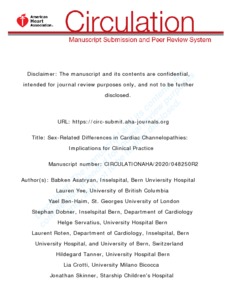Asatryan, B;
Yee, L;
Ben-Haim, Y;
Dobner, S;
Servatius, H;
Roten, L;
Tanner, H;
Crotti, L;
Skinner, JR;
Remme, CA;
et al.
Asatryan, B; Yee, L; Ben-Haim, Y; Dobner, S; Servatius, H; Roten, L; Tanner, H; Crotti, L; Skinner, JR; Remme, CA; Chevalier, P; Medeiros-Domingo, A; Behr, ER; Reichlin, T; Odening, KE; Krahn, AD
(2021)
Sex-Related Differences in Cardiac Channelopathies: Implications for Clinical Practice.
Circulation, 143 (7).
pp. 739-752.
ISSN 1524-4539
https://doi.org/10.1161/CIRCULATIONAHA.120.048250
SGUL Authors: Behr, Elijah Raphael
![[img]](https://openaccess.sgul.ac.uk/112977/1.hassmallThumbnailVersion/Sex-related%20differences%20in%20cardiac%20channelopathies%202021%20-%20AAM.pdf)  Preview |
|
PDF
Accepted Version
Available under License ["licenses_description_publisher" not defined].
Download (1MB)
| Preview
|
Abstract
Sex-related differences in prevalence, clinical presentation, and outcome of cardiac channelopathies are increasingly recognized, despite their autosomal transmission and hence equal genetic predisposition among sexes. In congenital long-QT syndrome, adult women carry a greater risk for Torsades de pointes and sudden cardiac death than do men. In contrast, Brugada syndrome is observed predominantly in adult men, with a considerably higher risk of arrhythmic sudden cardiac death in adult men than in women. In both conditions, the risk for arrhythmias varies with age. Sex-associated differences appear less evident in other cardiac channelopathies, likely a reflection of their rare(r) occurrence and our limited knowledge. In several cardiac channelopathies, sex-specific predictors of outcome have been identified. Together with genetic and environmental factors, sex hormones contribute to the sex-related disparities in cardiac channelopathies through modulation of the expression and function of cardiac ion channels. Despite these insights, essential knowledge gaps exist in the mechanistic understanding of these differences, warranting further investigation. Precise application of the available knowledge may improve the individualized care of patients with cardiac channelopathies. Promoting the reporting of sex-related phenotype and outcome parameters in clinical and experimental studies and advancing research on cardiac channelopathy animal models should translate into improved patient outcomes. This review provides a critical digest of the current evidence for sex-related differences in cardiac channelopathies and emphasizes their clinical implications and remaining gaps requiring further research.
| Item Type: |
Article
|
| Additional Information: |
This is a non-final version of an article published in final form in Asatryan, B; Yee, L; Ben-Haim, Y; Dobner, S; Servatius, H; Roten, L; Tanner, H; Crotti, L; Skinner, JR; Remme, CA; et al. (2021) Sex-Related Differences in Cardiac Channelopathies: Implications for Clinical Practice. Circulation, 143 (7). pp. 739-752. |
| Keywords: |
Brugada syndrome, arrhythmias, cardiac, death, sudden, cardiac, gender identity, genetics, long QT syndrome, sex, 1103 Clinical Sciences, 1102 Cardiorespiratory Medicine and Haematology, 1117 Public Health and Health Services, Cardiovascular System & Hematology |
| SGUL Research Institute / Research Centre: |
Academic Structure > Molecular and Clinical Sciences Research Institute (MCS) |
| Journal or Publication Title: |
Circulation |
| ISSN: |
1524-4539 |
| Language: |
eng |
| Dates: |
| Date | Event |
|---|
| 16 February 2021 | Published | | 15 February 2021 | Published Online | | 17 August 2020 | Accepted |
|
| Publisher License: |
Publisher's own licence |
| PubMed ID: |
33587657 |
 |
Go to PubMed abstract |
| URI: |
https://openaccess.sgul.ac.uk/id/eprint/112977 |
| Publisher's version: |
https://doi.org/10.1161/CIRCULATIONAHA.120.048250 |
Statistics
Item downloaded times since 22 Feb 2021.
Actions (login required)
 |
Edit Item |



